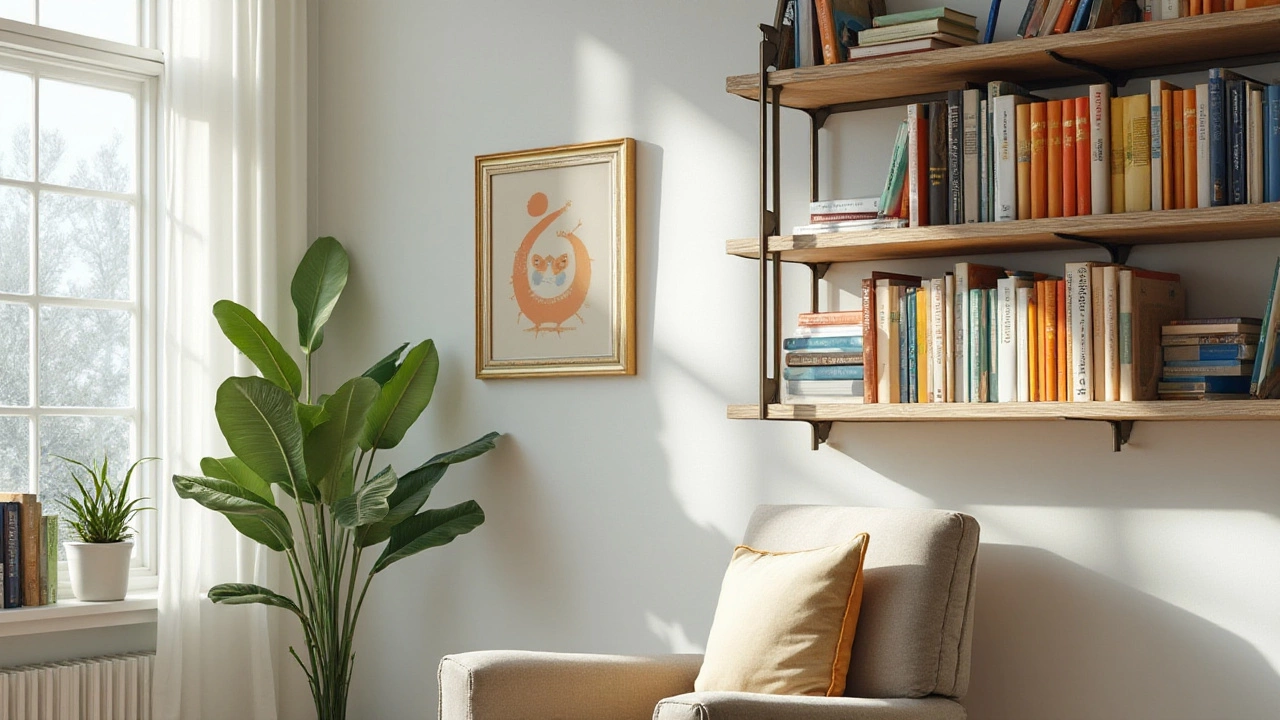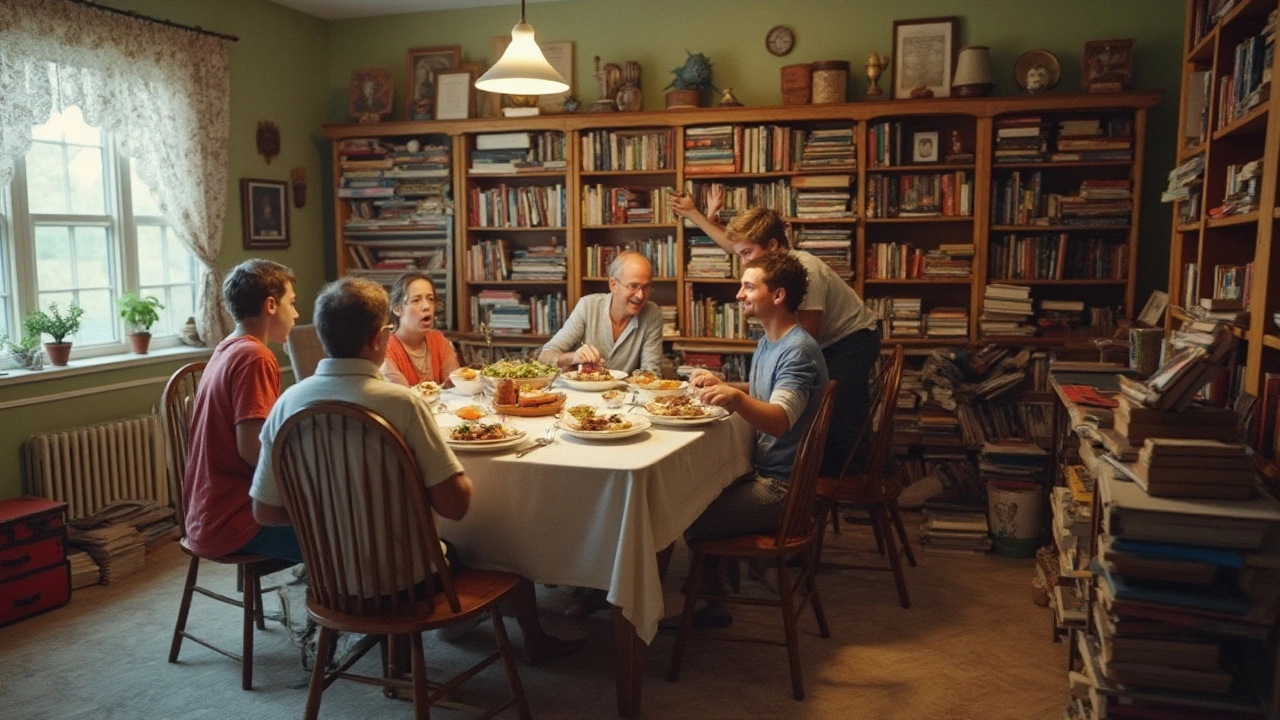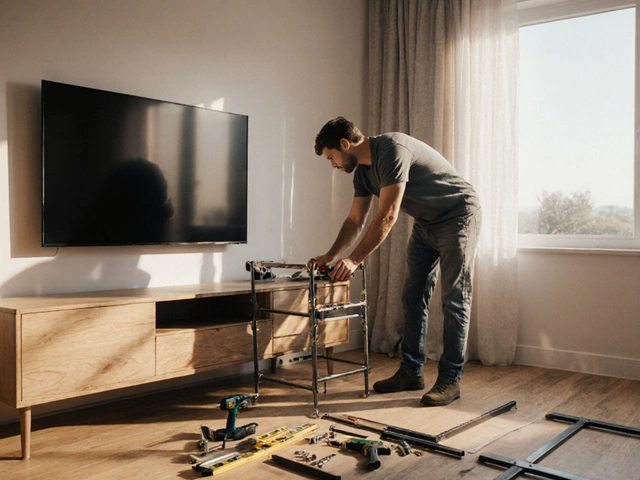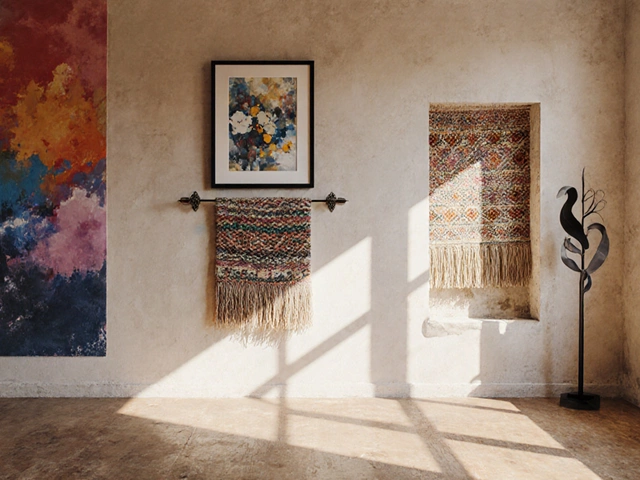
Positioning bookshelves is an art that marries practicality with aesthetics. You might think that finding the right spot for your bookshelf is as easy as picking a wall, but hold on—there's more to it than that. Making the wrong choice can affect not just the look of your room, but its functionality and your safety too.
Think about the potential pitfalls before you start moving those shelves around. Some locations are notorious for being bookshelf unfriendly, whether it's because of temperature, moisture, or simply because they disrupt the flow of a room. Let's dig deeper into some places you should definitely keep out of your list when considering where to put your bookshelves.
- Close to Heat Sources
- Near Plumbing Fixtures
- On Uneven Surfaces
- In Direct Sunlight
- Blocking Pathways
- Overcrowded Rooms
Close to Heat Sources
When it comes to placing bookshelves, one of the biggest mistakes homeowners make is putting them close to heat sources. Heat can not only cause damage to the materials of the bookshelf itself but also to the books and items it holds. Strong heat, especially when it's direct and intense, can warp wood, fade colors, and even cause adhesives to fail over time. Consider the impact continuous heat exposure will have on your bookshelves and the risk of fire hazards, which can become quite serious with flammable items like paper.
Books, made primarily of paper, are unfortunately quite vulnerable to high temperatures. Repeated exposure can lead to the yellowing of pages, brittleness, and in dire situations, combustion. According to expert preservationists, maintaining a stable environment for your books means keeping them away from radiators, heaters, and sunlight. A report by the National Fire Protection Association highlights the dangers of placing furniture like bookshelves near potential ignition sources, stating that furniture too close to heaters is a leading cause of residential fires.
Not to mention, modern heat solutions like radiators and floor heating can, over time, make the wood swell and crack. Decay also becomes a prominent concern because the materials in a bookshelf are often untreated for high heat endurance. For those with home decor in mind, think about the ugly scars and mismatches warped shelves bring to your beautifully arranged interior.
To ensure better longevity, keep at least three feet of distance between your bookcases and any heat sources if possible. If your room layout doesn't allow any other placement options, consider using heat-resistant barriers or moving to heat-stable materials like metal or tempered glass shelves for those areas. This preventive setup can help not only protect your investment in furniture but also keep your treasured reading collection in its best form. Remember, applying a little strategic caution today could save you significant headache and expense tomorrow.
Near Plumbing Fixtures
Placing a bookshelf near plumbing fixtures is a rookie mistake in home design that even the most seasoned decorators occasionally overlook. Imagine the horror of waking up to find your beloved collection of first editions soaked through because a nearby tap had a minor leak. Water and books are like oil and water—two entities that simply don’t mix. Plumbing fixtures, whether in the kitchen, bathroom, or basement, always carry a risk of leakage, and those unexpected drips can cause real damage to your cherished bookcases.
Plumbing is also susceptible to condensation, especially in homes where temperature fluctuations are common. Even the most meticulously maintained fixtures can produce moisture in their vicinity. Condensation forms when warm, moist air meets cooler surfaces, creating droplets that can subtly wreak havoc on your books. It's not just about immediate leaks; it’s also the slow buildup of humidity that can warp wood and disintegrate paper over time. Just think about a poorly ventilated bathroom—it's only a matter of time before the moisture affects everything around, including those seemingly stable bookshelves.
What's more, there's the issue of accessibility. You need to consider that one day, those pipes might need some attention. If your repairman has to clamber over a bookshelf teeming with novels, it complicates repairs and increases the risk of accidental damage to both the plumbing and the furniture. According to an article published in Home Maintenance Journal, "Accessibility is key in preventing minor repairs from turning into major headaches."
"When it comes to potential water damage, prevention truly is better and often cheaper than cure," noted Jack Thompson, a respected home plumbing consultant.
Taking into account these risks, wise homeowners often opt to keep bookshelves clear of areas near bathrooms, kitchens, or any other space where plumbing runs close by. If you're strapped for space, consider investing in moisture-resistant cabinetry for these locations. Dehumidifiers can also help manage ambient moisture levels. Actively monitoring these factors can mean the difference between a healthily preserved library and one beset by warping, discoloration, or worse.
As a key rule of thumb: always plan your bookshelf layout to minimize unnecessary environmental risks. This thoughtfulness not only extends the longevity of your furniture but keeps your favorite stories from taking an unscheduled swim. Trust your instincts—if you wouldn’t feel comfortable storing a valuable painting somewhere, then it probably isn’t the right place for your books either.

On Uneven Surfaces
Setting up a bookshelf on an uneven surface can lead to numerous challenges, and it's almost always a setup for disaster. At first glance, it might seem like a reasonable choice, especially if the area seems to match the rest of your decor. However, what you might not realize is the hidden havoc being wrought on both your bookshelves and the bookcases placed upon them. An unstable foundation can cause the shelf to tilt, lean, or in worst-case scenarios, even topple over. Think about the weight of all those books and knickknacks you plan to store. Uneven weight distribution can stress the shelves' joints and eventually lead to wear and tear far earlier than expected.
Gravity takes its toll on everything, and bookshelves are no exception. When your furniture stands on crooked floors, there's always a risk of books slipping off or the shelves sagging over time. This not only poses a hazard to your beloved collection but also to anyone who unwittingly walks past. Imagine the unfortunate surprise of a favorite hardcover slipping off the edge, narrowly missing your toes! It's vital to remember that if the flooring isn't balanced, then neither will be the structures sitting atop it.
In the quest to keep your home decor both stylish and safe, it's wise to consider your foundation. Use a level to check your floors before starting the installation process. Should you find that your intended spot is indeed bumpy or skewed, all is not lost. Various solutions can rectify the situation, such as shims or adjustable legs, both of which can stabilize your shelves without sacrificing style. Sometimes, a simple rearrangement of the room can open up new, more suitable locations.
From an aesthetic perspective, placing bookshelves on uneven surfaces may lead to a misalignment within your room’s design language. Symmetry often appeals to the human eye, and a teetering shelf does no favors in creating a polished look. It may clash with the rest of your interior design, creating an eyesore instead of a hallmark of your space. It's worthwhile to think about not only the physical balance of your furniture but also how it balances visually within the context of your living area.
An interesting note for those who love data: a study from the Home Safety Council has shown that furniture instability leads to numerous household injuries each year. These often overlook situations where furniture placement can convert into potential hazards. Anchoring your bookshelves properly or ensuring they're on level ground reduces these risks significantly. Safety should always go hand in hand with style, which is especially pertinent in homes with young children or pets.
So, next time you consider where to position your bookshelf, think twice about that uneven surface. It's worth the extra effort to choose your placement wisely to ensure that your treasured items and those close to you are safe while allowing your interior to stay inviting and secure. Remember, a sturdy base will do wonders for your bookshelf's longevity and your peace of mind.
In Direct Sunlight
Placing your beloved bookshelf right next to a sun-drenched window might initially seem like a fantastic idea — after all, what better way to showcase your cherished hardcovers and collectible tomes than in a well-lit, sunny glow? But beware, the alluring charm of direct sunlight can mask some serious pitfalls. When your books sit bathing in those rays all day long, both your books and the bookshelves endure a range of harmful effects.
First off, sunlight is infamous for its knack for causing fading and discoloration. Those rich, vibrant covers begin to lose their eye-catching appeal as UV rays slowly drain them of their original hues. Over time, these effects don't merely distort the aesthetic value of your collection. There's also the more practical concern of material degradation. The protective dust jackets and even the pages themselves can become brittle when exposed too long to sunlight, shortening their lifespan significantly.
Moreover, the condition of the bookcases themselves can be adversely affected. Wooden shelves may warp, crack, or lose their finish due to prolonged exposure to UV rays and heat, undermining their structural integrity. This deteriorating effect isn't restricted to wood. Metal can warp under fluctuating temperatures too, leading to uneven surfaces that add pressure to book spines. There's also the added risk of fire hazards, especially if magnifying objects like glass or mirrors are nearby.
"Given enough time, the sun damages everything—its light is relentless," noted an expert from a well-known conservation studio.
To sidestep these issues, consider protective solutions such as UV-filtering films on windows, or repositioning the bookcases away from direct sunlight entirely. If you're committed to keeping shelves where they are, rotate your collection frequently to avoid excessive exposure on particular books. Curtains or blinds are another simple yet effective method, allowing you to control the amount of natural light flowing into your favorite reading room.
Ultimately, the choice of where you place your bookshelves shouldn't just rest on aesthetics. Thoughtful planning can help you maintain both the beauty and integrity of your cherished collections, while simultaneously enhancing the utility and style of your living space.

Blocking Pathways
When considering the placement of bookshelves, it’s crucial to avoid obstructing pathways. This might sound obvious, but it happens more often than you’d think. Hallways, entryways, and the natural flow of a room are essential to maintain for comfortable living. The truth is, a well-placed bookshelf can serve as a captivating centerpiece, but a poorly positioned one can turn your lively home into an inconvenient maze. Interrupting pathways can lead to not only a cramped and visually cluttered space but also potential safety hazards for you and anyone else navigating the area.
Imagine stumbling through a narrow corridor, trying to dodge a protruding shelf in the middle of the night. It’s not a pleasant experience, and certainly not a safe one. It's not just about the look—think about accessibility. An open floor plan can seem inviting when every section flows smoothly into the next without any abrupt stoppages to trip over. Creating a fluid environment enhances not only the aesthetic beauty of your living area but also its functionality, making it more welcoming and easier to clean and organize.
In high traffic zones like corridors and living room entrances, think twice before setting up your bookcases. These areas demand freedom and space, allowing you and your guests to move with ease. Ensuring that bookshelves are out of harm's way isn't just a smart move stylistically; it’s necessary for safety and comfort. The convenience of movement within a living space connects directly with its overall enjoyment and utility. As the designer William Morris famously declared, "Have nothing in your home that you do not know to be useful, or believe to be beautiful." Blockages in pathways neither add utility nor allure, making them prime candidates for relocation.
If you're dealing with limited space and fear your options are shrinking, consider measuring where you've initially planned to place a bookshelf. You might find that a few inches here and there can make all the difference. Alternatively, explore wall-mounted shelving or corner units as a compromise that won't consume your precious floor space while still enabling you to showcase your literary collection beautifully.
As you ponder over the best location for your bookshelf, analyze the traffic patterns of each room. Observe how both you and your guests move through your home. Are there narrow passages that are essential to daily life? Is there a need for simplified and streamlined navigation? Weaving these considerations into your decor choices can transform an ordinary house into an extraordinary home, one where form and function coexist peacefully.
Overcrowded Rooms
When considering where to place a bookshelf, it's crucial to assess the overall balance of your room. Overcrowded rooms can pose a challenge as they not only make navigating the space difficult but can also cause significant stress and anxiety. The addition of a bulky bookcase into an already cramped space can tip the balance from cozy to chaotic, making the room feel more like a storage closet than a haven for relaxation.
Interior design experts often emphasize the importance of negative space, which is the empty area around your furniture. This space allows energy and light to flow freely, making a room feel open and inviting. A cluttered room with limited movement space can make everyday living cumbersome and less enjoyable. The decision to add a bookshelf should, therefore, be considered carefully, particularly when working with smaller or already densely furnished areas.
According to a study on Environmental Psychology, clutter can significantly impact mental well-being, contributing to a sense of overwhelm and lack of control. When bookshelves are squeezed into an area with too many items, it not only exacerbates the issue but also reduces their functional value. A well-placed bookshelf can indeed be a focal point, showcasing your treasured tomes and decorative pieces. Poorly placed, shelves can instead become just another source of clutter, lost amongst the chaos.
For those who love their literary collections, ensuring that these beloved pieces are showcased properly and don't add to the clutter is key. Consider alternative solutions to maximize space, such as wall-mounted shelves or even turning a lesser-used closet into a makeshift library. These options can allow for a creative outlet without overcrowding and compromise. A little imagination can transform a regular space into a reading nook retreat, capable of serving as both a functional storage solution and a pleasant aesthetic attribute.
According to leading designer, William Yeoward, "A properly balanced room accounts for both the needs of the people who use it and the balanced interactions between furniture and its inhabitants." This underscores the necessity of harmonizing your space without sacrificing function or comfort, particularly when designating places for larger items like bookcases.
Ultimately, achieving a harmonious environment might simply mean re-evaluating your existing setup. Look at how each piece of furniture contributes to the room's overall equilibrium and discard or relocate any superfluous items. The goal is to weave together your home decor in a way that celebrates your personal style while maintaining functionality. A bit of space planning can go a long way, ensuring that your bookshelf complements rather than competes with the rest of your room.



